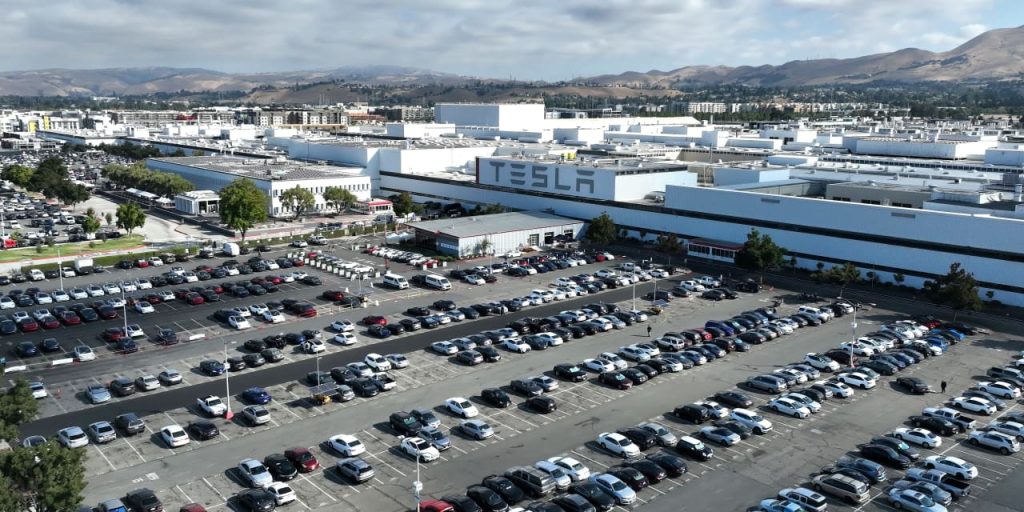Tesla delivered 435,059 units in the third quarter, below estimates.
Justin Sullivan/Getty Images
Electric vehicle leader
Tesla
delivered far fewer cars than Wall Street expected, yet the stock has headed higher after a drop in premarket trading.
Investors were bracing for a little bit of chaos, but not a result this bad.
For the third quarter, Tesla (ticker: TSLA) delivered 435,059 cars, while Wall Street was looking for closer to 455,000—a consensus figure compiled by the company relying on calls by 25 large brokers. Numbers had been all over the place ahead of the result. A few weeks ago, analysts were projecting 473,000 units, according to FactSet, while that number was 461,000 on Sunday.
Production was partly to blame. The company produced 430,488 units.
Tesla stock was down 3.8% in premarket trading at $240.62, but recovered for a gain of 0.4% to $251.30 by midday on Monday. Shares are bobbing up and down around break even in late trading. The
S&P 500
was down 0.2%, while the
Nasdaq Composite
was 0.4% higher.
The fact that investors had been bracing for a weak result is one reason for the market’s relatively neutral reaction.
Most of the time, Tesla estimates come down a little at the end of any quarter, typically by 1% to 2%. The range of estimates for the third quarter was about twice as wide as it was for the second quarter.
Still, Tesla’s delivery figure missed the bottom end of the FactSet estimates, and was worse than what the Street imagined. Deliveries fell about 7% compared with the record 466,140 vehicles delivered in the second quarter.
A big reason for the drop, according to many analysts, is plant shutdowns scheduled to upgrade Tesla’s factories. The company is about to deliver a refreshed Model 3 in Europe and China.
That was at least partly reflected in the stock before the delivery figure was disclosed. Coming into Monday trading, the stock had fallen about 14% since management talked about third-quarter downtime at its factories when it disclosed its latest earnings. The S&P 500 and Nasdaq are down about 6% and 8%, respectively, over that span.
Canaccord analyst George Gianarikas was looking past the weak third-quarter number, citing the plant downtime. “Demand appears relatively healthy for Tesla despite a wobbly auto market and some price cuts this quarter, particularly with new products set for launch in the second half of 2023, including the revamped Model 3 and Cybertruck, as well as a slightly upgraded Model Y announced this weekend in China,” wrote the analyst in a Monday report.
He rates Tesla shares Buy and has a $293 price target for the stock.
The plant downtime sapped more volume than Wall Street expected. Production didn’t come close to covering delivery estimates. Tesla produced some 430,000 vehicles, down about 49,000 units from the 479,700 produced In the second quarter.
One bright spot is that sales exceeded production. That means inventories shrank for the first time since the first quarter of 2022.
Another positive factor is that management is sticking with a forecast that it expects to deliver about 1.8 million vehicles for all of 2023. That leaves about 475,000 to deliver in the fourth quarter, while Wall Street is projecting 490,000 vehicles.
When delivery numbers turn out to be better than expected, Tesla stock goes up between that disclosure and the earnings report about two-thirds of the time. It isn’t hard to understand why. Better deliveries mean rising earnings estimates.
Deliveries in the third quarter weren’t anywhere near a “beat,” but Tesla’s deliveries also fell short of forecasts for the last three months of 2022. Shares fell 12.% on Jan. 3, the first trading day after the numbers were released.
There is always a lot going on with Tesla stock. A quarterly delivery figure is one of the things that matter to investors and the delivery number can generate a lot of trading volatility. The rebound on Monday morning illustrates how the stock can move.
Write to Al Root at [email protected]
Read the full article here
